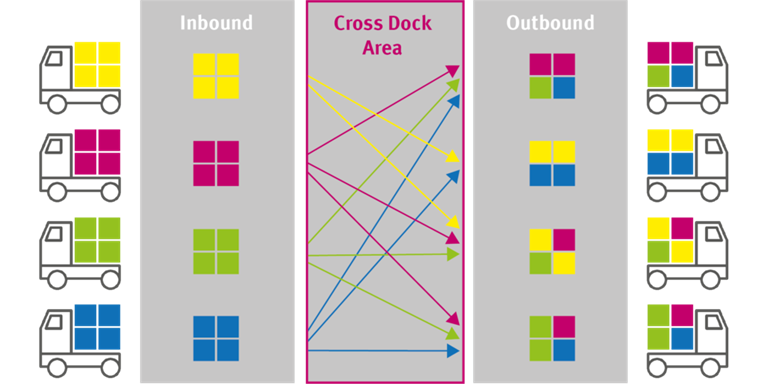Cross Docking
Cross docking is a specific type of transshipment that does not include warehousing. Here, the order picking for the goods has already been carried out by the supplier/sender and the goods are not placed in stock, but are directly transshipped and dispatched again. The process implements the flow principle in that supply and demand are always synchronised. It originates from the just-in-time/just-in-sequence principle.
Figuratively, the origin of the cross docking process can be derived in such a way that a “crosswise” goods receipt takes place on one side of the building, while the trucks are loaded again on the opposite side of the building. The following cross docking example with an image explains this process.
Cross docking goals
The goal of cross docking is to reduce process steps and warehousing costs. The cross docking centre should be a transshipment point with a steady flow.
Cross docking requirements
Cross docking requires efficient planning and a smooth flow of information. It is particularly suitable for companies that manage large quantities of goods and have many incoming and outgoing goods. High delivery reliability, known delivery quality and a sufficient delivery volume are also useful.
Advantages
- Shorter lead times
- Faster processing even of large quantities of goods
- Timely delivery
- Fewer process steps
- No order picking effort
- Minimisation of warehousing costs and goods stock
Disadvantages
- Increased communication effort as a challenge
- Increased need for IT support
- Need for digitised information flows and automated warehouse processes
- Need for powerful warehouse software
Cross docking variants
Based on the definition of cross docking, the following variations exist:
- One-tier system: Prepicking is carried out by the supplier in relation to the final receiver. The goods are marked by the sender/supplier with the receiver data and–via different transshipment points–sent to the final receiver without being changed.
- Two-tier system: With this system, the goods are forwarded unchanged to the transshipment point. There, order picking is carried out on new units, e.g. splitting or merging the goods. Afterwards, the goods are delivered to the final receiver.
- Multi-tier system: As a supplement to the two-tier system, further process steps are added here. These are, for example, repackaging, assembly or labelling of the goods.
Example

Three suppliers deliver prepicked, unmixed goods for electronics stores by truck to the incoming goods dock of the transshipment point. For example, truck A delivers cameras, truck B USB charging cables and truck C PC keyboards.
In the one-tier system, according to the cross docking definition, the goods are forwarded from the incoming goods dock to the outgoing goods dock without further processing at the transhipment point in Kempten. In the two-tier/multi-tier system (see definition above), further steps take place.
Subsequently, the various goods are loaded onto trucks 1, 2 and 3 at the outgoing goods dock of the transshipment point, which in our example deliver to various branches of the electronics store. For example, truck 1 drives to Stuttgart, truck 2 delivers to the branch in Munich and truck 3’s tour leads to Innsbruck. Trucks 1 to 3 thus contain different quantities of the goods from trucks A to C and there is no intermediate storage.
With our cross docking software CarLo inHUB, we provide a flexible add-on that will allow you to cover all cross docking processes in the logistics sector. The goal is comprehensive hub control for the integration of all cross docking processes, from the sender via transshipment at the hub to the receiver.
See also:
Depot In the logistics industry, the term is used synonymously with <a href="https://www.soloplan.com/service/logistics-glossary/transshipmen [...] Transshipment In forwarding, the term refers to one of the most important logistics processes. It describes the switch of the <a href="https: [...]